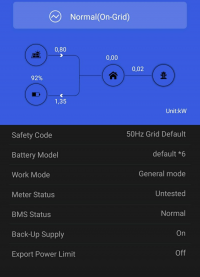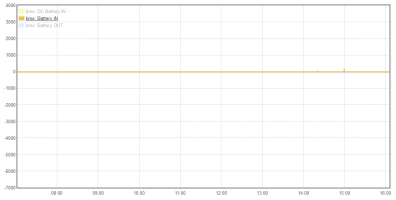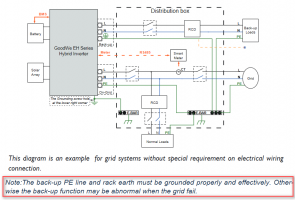[{"id":"53deaa97.dc54d4","type":"udp in","z":"ad27c33e.22c658","name":"","iface":"","port":"8899","ipv":"udp4","multicast":"false","group":"","datatype":"buffer","x":100,"y":1100,"wires":[["c87fdbb6.c021d8","a970b4ba.9a1428"]]},{"id":"a970b4ba.9a1428","type":"debug","z":"ad27c33e.22c658","name":"","active":false,"console":"false","complete":"true","x":250,"y":1160,"wires":[]},{"id":"6471bc3d.8d6744","type":"udp out","z":"ad27c33e.22c658","name":"","addr":"","iface":"","port":"8899","ipv":"udp4","outport":"8899","base64":false,"multicast":"false","x":650,"y":980,"wires":[]},{"id":"108de66.72b1e9a","type":"function","z":"ad27c33e.22c658","name":"Request","func":"msg.payload = Buffer.from(\"f703891c0078bae4\", \"hex\");\nreturn msg;\n\n","outputs":1,"noerr":0,"x":360,"y":980,"wires":[["6471bc3d.8d6744"]]},{"id":"51e8bd17.fe18ec","type":"inject","z":"ad27c33e.22c658","name":"10s","topic":"","payload":"","payloadType":"date","repeat":"10","crontab":"","once":false,"x":110,"y":980,"wires":[["108de66.72b1e9a"]]},{"id":"c87fdbb6.c021d8","type":"function","z":"ad27c33e.22c658","name":"Parse data","func":"\nvar data = {};\n\ndata.PV1_V = msg.payload.readInt16BE(11) / 10;\ndata.PV1_I = msg.payload.readInt16BE(13) / 10;\ndata.PV1_P = msg.payload.readInt32BE(15);\n// data.PV2_V = msg.payload.readInt16BE(19) / 10;\n// data.PV2_I = msg.payload.readInt16BE(21) / 10;\n// data.PV2_P = msg.payload.readInt32BE(23);\n// data.PV3_V = msg.payload.readInt16BE(27) / 10;\n// data.PV3_I = msg.payload.readInt16BE(29) / 10;\n// data.PV3_P = msg.payload.readInt32BE(31);\n// data.PV4_V = msg.payload.readInt16BE(35) / 10;\n// data.PV4_I = msg.payload.readInt16BE(37) / 10;\n// data.PV4_P = msg.payload.readInt32BE(39);\ndata.PV_MODE = msg.payload.readInt16BE(43);\n// data.UNKNOWN = msg.payload.readInt16BE(45);\ndata.V_L1 = msg.payload.readInt16BE(47) / 10;\ndata.I_L1 = msg.payload.readInt16BE(49) / 10;\ndata.F_GRID_R = msg.payload.readInt16BE(51) / 100;\ndata.POWER_L1 = msg.payload.readInt32BE(53);\n// data.V_L2 = msg.payload.readInt16BE(57) / 10;\n// data.I_L2 = msg.payload.readInt16BE(59) / 10;\n// data.F_GRID_S = msg.payload.readInt16BE(61) / 100;\n// data.P_L2 = msg.payload.readInt32BE(63);\n// data.V_L3 = msg.payload.readInt16BE(67) / 10;\n// data.I_L3 = msg.payload.readInt16BE(69) / 10;\n// data.F_GRID_T = msg.payload.readInt16BE(71) / 100;\n// data.P_L3 = msg.payload.readInt32BE(73);\ndata.GRID_MODE = msg.payload.readInt16BE(77);\ndata.TOTAL_INV_POWER = msg.payload.readInt32BE(79);\ndata.AC_ACTIVE_POWER = msg.payload.readInt32BE(83);\ndata.AC_REACTIVE_POWER = msg.payload.readInt32BE(87); //???\ndata.AC_APPARENT_POWER = msg.payload.readInt32BE(91); //???\ndata.BACK_UP_V_LOAD_R = msg.payload.readInt16BE(95);\ndata.BACK_UP_I_LOAD_R = msg.payload.readInt16BE(97);\ndata.BACK_UP_F_LOAD_R = msg.payload.readInt16BE(99);\ndata.LOAD_MODE_R = msg.payload.readInt16BE(101);\ndata.BACK_UP_P_LOAD_R = msg.payload.readInt32BE(103);\ndata.BACK_UP_V_LOAD_S = msg.payload.readInt16BE(107);\ndata.BACK_UP_I_LOAD_S = msg.payload.readInt16BE(109);\ndata.BACK_UP_F_LOAD_S = msg.payload.readInt16BE(111);\ndata.LOAD_MODE_S = msg.payload.readInt16BE(113);\ndata.BACK_UP_P_LOAD_S = msg.payload.readInt32BE(115);\ndata.BACK_UP_V_LOAD_T = msg.payload.readInt16BE(119);\ndata.BACK_UP_I_LOAD_T = msg.payload.readInt16BE(121);\ndata.BACK_UP_F_LOAD_T = msg.payload.readInt16BE(123);\ndata.LOAD_MODE_T = msg.payload.readInt16BE(125);\ndata.BACK_UP_P_LOAD_T = msg.payload.readInt32BE(127);\ndata.P_LOAD_R = msg.payload.readInt32BE(131);\ndata.P_LOAD_S = msg.payload.readInt32BE(135);\ndata.P_LOAD_T = msg.payload.readInt32BE(139);\ndata.TOTAL_BACK_UP_LOAD = msg.payload.readInt32BE(143);\ndata.TOTAL_LOAD_POWER = msg.payload.readInt32BE(147);\ndata.UPS_LOAD_PERCENT = msg.payload.readInt16BE(151);\n\ndata.AIR_TEMPERATURE = msg.payload.readInt16BE(153) / 10;\ndata.MODULE_TEMPERATURE = msg.payload.readInt16BE(155) / 10;\ndata.RADIATOR_TEMPERATURE = msg.payload.readInt16BE(157) / 10;\n\ndata.FUNCTION_BIT_VALUE = msg.payload.readInt16BE(159);\n\ndata.BUS_VOLTAGE = msg.payload.readInt16BE(161) / 10;\ndata.NBUS_VOLTAGE = msg.payload.readInt16BE(163);\n\ndata.V_BATTERY1 = msg.payload.readInt16BE(165) / 10;\ndata.I_BATTERY1 = msg.payload.readInt16BE(167) / 10;\ndata.P_BATTERY1 = msg.payload.readInt32BE(169);\n\ndata.BATTERY_MODE = msg.payload.readInt16BE(173);\ndata.WARNING_CODE = msg.payload.readInt16BE(175);\ndata.SAFETY_COUNTRY = msg.payload.readInt16BE(177);\ndata.WORK_MODE = msg.payload.readInt16BE(179);\ndata.OPERATION_MODE = msg.payload.readInt16BE(181);\ndata.INV_ERR_H = msg.payload.readInt16BE(183);\ndata.INV_ERR_L = msg.payload.readInt16BE(185);\n\ndata.PV_E_TOTAL = msg.payload.readInt32BE(187) / 10;\ndata.PV_E_DAY = msg.payload.readInt32BE(191) / 10;\ndata.E_TOTAL = msg.payload.readInt32BE(195) / 10;\n\ndata.H_TOTAL = msg.payload.readInt32BE(199) / 10;\ndata.E_DAY_SELL = msg.payload.readInt16BE(203) / 10;\ndata.E_TOTAL_BUY = msg.payload.readInt32BE(205) / 10;\ndata.E_DAY_BUY = msg.payload.readInt16BE(209) / 10;\ndata.E_TOTAL_LOAD = msg.payload.readInt32BE(211) / 10;\ndata.E_LOAD_DAY = msg.payload.readInt16BE(215) / 10;\ndata.E_BATTERY_CHARGE = msg.payload.readInt32BE(217) / 10;\ndata.E_CHARGE_DAY = msg.payload.readInt16BE(221) / 10;\ndata.E_BATTERY_DISCHARGE = msg.payload.readInt32BE(223) / 10;\ndata.E_DISCHARGE_DAY = msg.payload.readInt16BE(227) / 10;\n\ndata.BATT_STRINGS = msg.payload.readInt16BE(229);\ndata.CPLD_WARNING_CODE = msg.payload.readInt16BE(231);\ndata.W_CHARGER_CTRL_FLAG = msg.payload.readInt16BE(233);\ndata.DERATE_FLAG = msg.payload.readInt16BE(235);\ndata.DERATE_FROZEN_POWER = msg.payload.readInt16BE(237);\ndata.DIAG_STATUS_H = msg.payload.readInt16BE(239);\ndata.DIAG_STATUS_L = msg.payload.readInt16BE(241);\n\nmsg.payload = data;\nmsg.topic = \"goodwedata\";\nmsg.nodegroup = \"goodwedata\";\n\nreturn msg;","outputs":1,"noerr":0,"x":370,"y":1100,"wires":[["35d6e082.5d68c8","2941a42.2eb1edc","1506434.3749e3d"]]},{"id":"35d6e082.5d68c8","type":"mqtt out","z":"ad27c33e.22c658","name":"","topic":"","qos":"","retain":"","broker":"13b7e580.da6483","x":590,"y":1040,"wires":[]},{"id":"2941a42.2eb1edc","type":"emoncms","z":"ad27c33e.22c658","name":"Emoncms Push","emonServer":"ca9051bf.f69eb8","nodegroup":"","datatype":"legacy","x":620,"y":1100,"wires":[]},{"id":"1506434.3749e3d","type":"debug","z":"ad27c33e.22c658","name":"","active":false,"console":"false","complete":"false","x":610,"y":1160,"wires":[]},{"id":"13b7e580.da6483","type":"mqtt-broker","z":"","broker":"","port":"1883","clientid":"","usetls":false,"compatmode":true,"keepalive":"15","cleansession":true,"willTopic":"","willQos":"0","willPayload":"","birthTopic":"","birthQos":"0","birthPayload":""},{"id":"ca9051bf.f69eb8","type":"emoncms-server","z":"","server":"","name":"emoncms"}]













